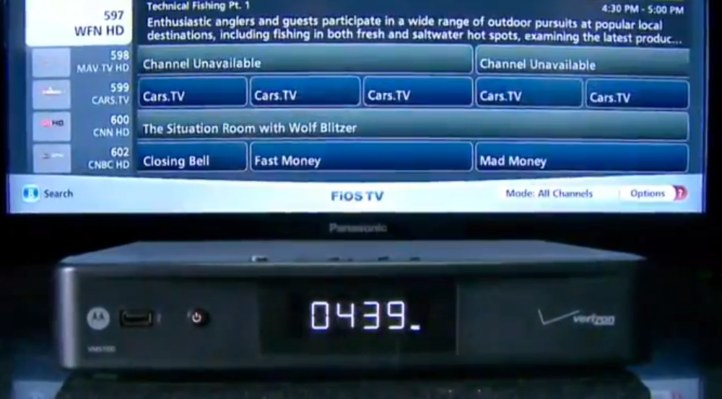Remember that FiOS home Media Server Verizon was talking about a year ago? Well, the company is finally starting to make things official, with an announcement and product details revealed today at CES. Launch date and pricing info still remain elusive, however.
Verizon and Motorola have jointly developed the new Media Server platform, which doesn’t have a snazzy name like “Apple TV” or “Google TV,” but is rather called the Motorola Medios+ VMS1100 Media Server and the Motorola Mediaos+ IPC1100 IP-based set-top. (Oh, you guys and your clever names!) But the naming isn’t as important here, since the idea is that this would one day just replace your Verizon set-top box.
In any event, the solution will address several pain points for current Verizon FiOS subscribers. The server will support up to five separate TVs, meaning each TV can be tuned into different programming without any conflicts. To be clear, that’s one TV connected to the Media Server itself, then up to four other set-top boxes.
Even if you don’t have a house filled with nearly half a dozen TVs, you’ll be able to take advantage of the Media Server because it will allow you to record up to six TV shows at the same time, which can then be viewed on all the connected TVs. Seriously, this would solve a huge issue in our house where we’re constantly interrupted with “conflicts detected” messages as multiple programs kick off recording at the same time. And if you’re not around to respond, Verizon’s DVRs currently default to your Series Manager lineup rankings, which is often a poor reflection of the TV you actually care about seeing since most people don’t take the time to re-order their programming by priority.
For all those extra recordings you’ll now end up with, the Media Server offers one terabyte of internal storage, which equates to 100 hours of HD content or weeks of SD programming. The IPC1100 client set-top box accesses that content over a coax cable, similar to how Verizon FiOS’s multi-room DVRs operate today. The client, however, has a lower profile than the current DVRs, as it’s described as being “as thin as paperback novel.”
The Media Server also includes performance improvements, says Verizon, which should hopefully make browsing the on-demand library and content guide a bit speedier. And it offers a feature that will let you shop from over 15 home shopping channels and purchase items using your remote. If only this functionality worked with TV commercials. Maybe one day?
Other widgets are available, too, as always, including the YouTube widget which lets you search for and view video on the TV. Previously, this widget required users run desktop software on their PC, but the Media Server will not.
The Media Server and client devices will run Motorola’s Medios+ DreamGallery software, which supports smart searches and personalization via favorites, customizable menus and recommendations. (The DreamGallery link points to a video showing software than looks different than what Verizon shows in its own video above, thankfully).
More importantly, well, perhaps to TechCrunch readers, is that the Media Server platform works with iPads, Xboxes, and Connected TVs. Verizon FiOS, in fact, recently launched an iPad app which lets viewers watch live TV while connected to the home’s Wi-Fi network. It’s not a bad experience, either, except for the fact that DVR recordings aren’t available – although that has to do with licensing issues, as opposed to Verizon’s choice.
While the iPad app was a great addition for FiOS users, Verizon notes that 80% of its customer base prefers watching TV content on TVs. That seems to be par for the course, Nielsen also noted today in a 2012 year-end wrap up report.
The delay to launch in the previously announced 2012 time frame may have had to do with issues surrounding the FCC rule mandating a Dec. 1, 2012 deadline for working with open home-networking standards. Verizon commented on TiVo’s request for a waiver of those rules, saying that the FiOS Media Server worked with standards from the Digital Living Network Alliance (DLNA) and the Multimedia over Coax Alliance (MoCA), but those standards were a “work in progress.” Verizon also noted that DLNA’s next standard would probably not be approved until 2013. The FCC later extended the deadline for compliance to June 2, 2014, which paved the way for the FiOS Media Server’s launch in 2013.
